#Polychrome Jar
Explore tagged Tumblr posts
Text



Jar with snakes and giraffes
Egypt, Lower Nubia, Karanog Cemetery
Meroitic Period, 100 BCE - 300 CE
Ceramic, paint; H. 34 cm, Dia. 29.4
Penn Museum E8183
“Undulating snakes curve around the top of this jar. On the frieze below, giraffes - which were native to Upper Nubia - eat from tall trees.”
#animals in art#museum visit#ceramics#jar#pottery#ancient art#ancient Egypt#Meroitic art#polychrome#snake#snakes#giraffe#giraffes#African art#African animals#Penn Museum
72 notes
·
View notes
Text

Polychrome lided jar, Casas Grande culture (Chihuahua, Mexico) 13th-15th century
from The Dallas Museum of Art
244 notes
·
View notes
Text
A crash course in some vocabulary
Archaeology, like all sciences, has a lot of specialized jargon we use to talk about pottery. To make sure everyone’s on the same page, here’s a list of some common terms I’ll be using, what they mean, and how to pronounce them.
~ 🏺🏺🏺 ~
Ware: A broader term for a technological/cultural tradition in pottery. Typically, construction method, color, clay type, temper type, and paint type are what defines a “ware.” So Chuska Gray Ware is unslipped, usually unpainted gray clay with crushed black basalt temper. Roosevelt Red Ware is red-slipped clay with sand temper and carbon-based paint. Hohokam Buff Ware is unslipped or cream-slipped buff-colored clay with coarse sand temper, created using a paddle-and-anvil forming method and painted with red paint.
Type: Within a ware, a type is a more narrowly specific decorative style. Roosevelt Red Ware has multiple types within it, such as Salado Red (unpainted red-slipped), Pinto Black-on-red (black paint on the red in a specific radially symmetric interlocked hatched-and-bold pattern), Pinto Polychrome (same decorative style but on a white-slipped interior field), Gila Polychrome (red exterior, white-slipped interior, a usually-broken black band around the rim, black painted designs in a two- or -four-fold symmetry), Tonto Polychrome (bolder and less symmetric black-and-white designs on a red field), Cliff Polychrome, Dinwiddie Polychrome, Nine Mile Polychrome… different stylistic variations on the Roosevelt Red Ware technological/visual core. You can read more about categorizations here.
A note on naming conventions: Pottery in this archaeological tradition tends to have a two-part name: a location where it was first defined and described, and a colorway. Wares tend to be “[Broad location or broad cultural group] [Color] Ware”; types tend to be “[Specific site] [paint color]-on-[clay color].” So within Tusayan White Ware is Flagstaff Black-on-white.
———
Gila: A river in southern Arizona and a bit of New Mexico, and a lizard and a polychrome type named after it. Pronounced hee-la.
Hohokam: An archaeological term for a Native American cultural group that lived in southern Arizona and northern Sonora, defined by traits like red-on-buff pottery, massive canal systems for field irrigation, and platform mounds. It comes from the O'odham-language word huhugham, “ancestors.” They are the ancestors of the modern Tohono O’odham and Akimel O’odham people (it’s a little bit more complicated than that but that’s basically the case.)
Mogollon: An archaeological term for a Native American cultural group from central New Mexico, eastern Arizona, and northern Chihuahua. Most iconic trait is the elaborate range of corrugated and smudged pottery. Named after the Mogollon Rim, the geological formation that marks the edge of the Colorado Plateau and a drastic change in geology and climate in the northern Southwest and the southern Southwest. Along with the Ancestral Pueblo, the Mogollon culture are ancestors of modern southern Rio Grande and Zuni pueblos. Pronounced moh-guh-yon.
Olla: A water jar with a wide body and narrow neck. Pronounced oy-ya.
Polychrome: Pottery that is three or more colors (poly+chrome), most often meaning red, white, and black.
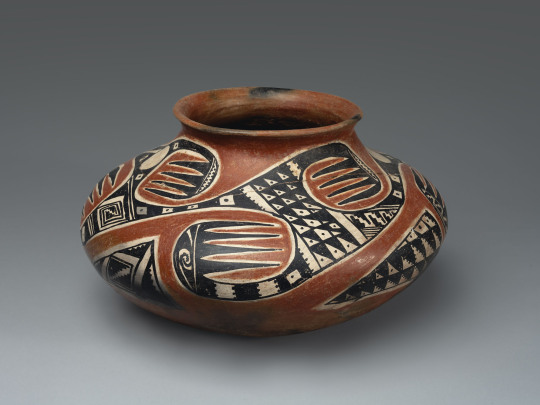
A Tonto Polychrome olla. Southeastern Arizona, 1350-1450.
Pueblo: A collective term for Native people of the Southwest US (particularly in the Rio Grande river watershed, but also Hopi and Zuni) who share cultural traits and history—most immediately notably, a tradition of living in square adobe houses in large villages, which are also each called pueblos. Ancestral Pueblo is the term for the archaeologically-defined cultural group that share these similar traits and are, generally, from the northern half of New Mexico and Arizona, and a southern strip of Colorado and Utah. The Ancestral Puebloans were formerly called “Anasazi” but that has fallen out of favor due to pushback from modern Pueblos. Also, each modern Pueblo prefers to be called a Pueblo rather than a tribe in most cases—so you say the Pueblo of Acoma, the Pueblo of Ohkay Owingeh, Picuris Pueblo, Taos Pueblo, the Pueblo of Zuni, etc.
Temper: Non-clay bits that are added to natural clays to make them easier to work with. When you buy clay from a store now, it’s already mixed and processed and ready to use. When you find clay out in nature, it’s almost never so easy. Typically, you have to mine/harvest clay from riverbanks or cliffsides, and it’s hard and dried; then you have to grind the hard clay up into fine particles, and mix them with water. But natural clays are often puddly and don’t always hold together well, so you add temper, something hard and grainy to make your wet clay stick together more easily and make it good to work with! Temper can be sand, ground-up rock, ground-up shell, or even ground-up bits of other broken pottery. What different people used as temper is one defining feature of a pottery ware and pottery tradition.
Sherd: A broken bit of pottery. NOT shard. When it’s pottery, it’s “sherd.”
Slip: Very runny wet clay. It’s used to help attach clay pieces together, but more pertinently here, plain-colored pots are covered with an even layer of bolder-colored clay slip to get the desired color pot.
Smudging: A decorative style that potters made during the firing stage. They would have open pit-fires for firing their pottery, and cover the desired part of the pot with a layer of charcoal or ash. This creates a carbonized, reducing environment—that is, a lot of carbon, and little oxygen. This creates a smooth, inky black finish on the completed pot.
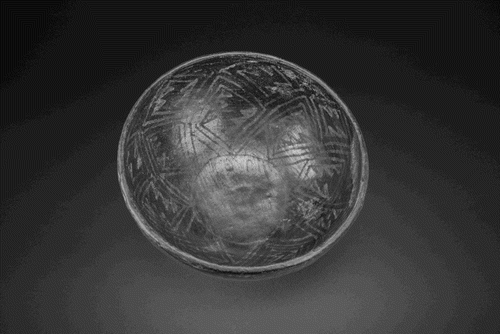
A Starkweather Smudged bowl. Mogollon, western New Mexico, AD 900-1200.
Vessel: Another word for pot, basically. Means a ceramic container of some sort. Bowls, jars, ladles, pitchers, mugs, etc are all vessels; effigies and statuettes are not.
56 notes
·
View notes
Note
Top 5 pieces of pottery!
Heck YEAH! There are so many excellent pots in the world.
This delightful Tonto Polychrome bowl from Gila Pueblo, eastern Arizona, late 1300s. It’s everybody’s favorite at the museum for a reason.

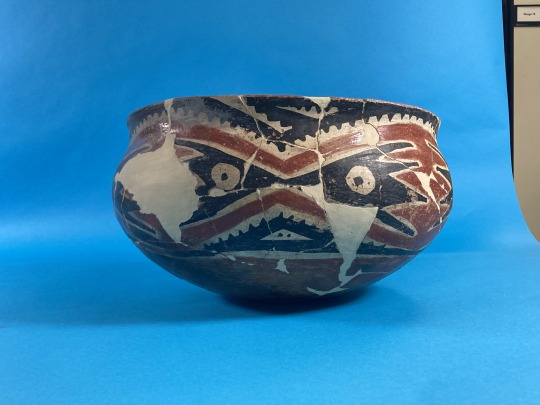
2. Late Minoan Marine Style pottery, and specifically the famous octopus flask (Palaikastro, Crete, 1500s BCE). I love how there was a whole stylistic movement to just paint sea creatures on fancy pots at this point in time.
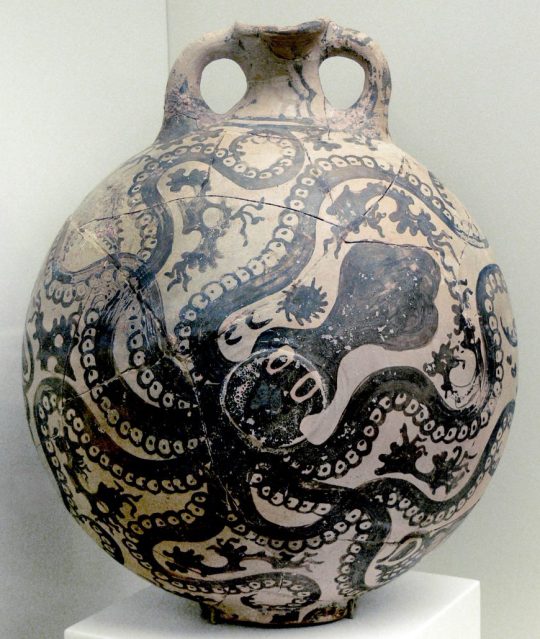
3. This particular Mesa Verde mug, southern Colorado, 1200s. There are a LOT of mugs from the 1100s-1200s in the style, but I like the swirly pattern on this one. A friend of mine has a replica of it. I drank tea out of it when I was dog-sitting for her.

4. The Chaco Canyon cylinder jar collection from Pueblo Bonito, Central New Mexico, 900s-1000s. Makes the top five for their archaeological interest—chocolate residue was found on the inside, showing that chocolate was imported up from Mexico to New Mexico and the people in Chaco Canyon were drinking chocolate out of these jars probably in a similar ritual manner to how Maya people were doing it at the same time down in Mexico. After the 1100s cylinder jars fell out of fashion and chocolate was drunk from mugs instead. (Similar to the one above.)

5. Brithawon’s shit-ass kylikes (Pylos, Greece, 1200s BCE). Love this guy.

also special shout-out to a new love, the Hellenistic Greek eyebrow fish plates.
hmm maybe I should do a part 2 with modern/art pottery also... there are also some excellent pots that are not hundreds of years old
36 notes
·
View notes
Text

San Ildefonso Pueblo, Polychrome Jar with Red Rim. clay, pigment, 10-1/4” tall x 12” diameter.
18 notes
·
View notes
Text

#Hopi #Pueblo (Above, top) Polacca polychrome bowl, Hopi, 19"" century. Gift of John Mitchel (Beside, middle) Jar signed by Dextra Quotskuyua Nampeyo. Hopi, 1984. Gift of Audrey Melamed.
2 notes
·
View notes
Text

TALL RING BASE JAR
Clay with polychrome decoration 11" high. Puebla area, Mexico.
Postclassic Period. A.D. 1300-1500
LOS ANGELES MUSEUM OF NATURAL HISTORY
10 notes
·
View notes
Text
https://mistantiques.co.uk/product/decorative-antique-japanese-cloisonne-tea-jar-and-lid-with-green-enamelling-and-a-floral-design/
A pretty and appealing mid century antique cloisonné cylindrical tea jar and lid. Designed with polychrome decoration showing various small decorative exotic flowers, which are offset against a vivid green background, the inside and base being enamelled in a traditional turquoise colour.
0 notes
Text
Ming dynasty (1368–1644)
Ewer with Paired Dragons amid Cloud Scrolls China Ming dynasty (1368-1644), zhengde reign mark and period (1506-21) Porcelain painted in overglaze green and yellow enamels Gift of Russell Tyson, 1954-473 Garlic-Headed Bottle with Mandarin Ducks and Birds in a Lotus Pond China Ming dynasty (1573-1620) Porcelain painted in underglaze blue and overglaze polychrome enamels Gift of Russell Tyson, 1964.692 The introduction of brightly colored enamels brought new vibrancy to porcelain design and new challenges to Chinese Potters. Enamel colorants derive from metalic oxides and can be applied only to fired porcelains- usually, but not always, after glazing. As enamel fuses to the porcelain body at a lower, temperature, it requires a separate firing in a separate kiln, Successive firing at precisely different temperatures added additional layers of technical complexity to a demanding process that already requires the collaboration of countless specialists. These vessels reflecting the range of designs, colors, techniques and levels of quality in enamel decoration found in imperial porcelains from the 16th and early 17th centuries. Unlike other vessels in this case, the yellow-and-Green ewer and bowl at the far right were enamled directly on the underglazed clay. More complex palettes combine underglaze blue and underglaze polychrome enamels. These traditionally termed wucal- literally, “ five colors” -regardless of the number of colors applied in addition to the all- pervasive dragon, seen here are bold aquatic scenes and even caricature-like figures of Taoist immortals. Some porcelains are meticulously decorated, others more casually so. Dish with floral and fruit Sprays (“Gardenia Dish”) Ming dynasty (1368-1644), Hongzhi reign Mark and period (1488-1505) China Porcelain painted in underglaze blue and Overglaze enamel Charles H. and Mary F.S.Worcester Collection Fund, 2016.97 Recent Acquisition Perhaps commissioned for imperial dining, this dish abound in auspicious botanical imaginary. The motifs were first painted in underglaze blue and careful silhouetted with brilliant yellow enamel before retiring. The flower at the center, a gardenia, is admired for its beauty and fragrance as well as valued to for its use in the production of pigment and traditional herbal medicine. Each of the four plants encircling the gardenia blossom has symbolic importance: the pomegranates allude to fertility persimmons to wealth; grapes, vines and seeds to progeny; and lotus to purity. Rose blossoms and budding stems, signifying longevity, encircling the exterior. This dish was formerly in the collection of Edward H. Bennet (1874-1954), a prominent Chicago architect best known as the designer of Buckingham Fountain. Bowl with Gold of Longevity (Shoulao) and Eight Taoist Immortals China Ming dynasty (1388-1644), Wanli reign mark and period (1573-1620) Porcelain painted in underglaze blue and overglaze polychrome enamels Gift of Dorothy Braude Edinburg to the Harry B. and Bessie K. Braude Memorial Collection, 2002.628 The unconventional figures encircling this bowl are Taoist immortals: historical persons and legendary characters to collectively symbolize good fortune and individually denote different conditions of the life (wealth, poverty, youth, old age, etc.) the central figure depicts the God of Longevity (Shaolao), identifiedmby his scepter and domed cranium. Covered Hexagonal Lobed Jar with Dragon Chasing a Flaming Pearl Ming dynasty (1368-1644), Wanli reign mark and period (1573-1620) China Porcelain painted in underglaze blue and overglaze polychrome enamels Gift of Russell Tyson, 1951.300 Vase in the Form of a Bronze Wine Vessel, with Dragons, Waves and Trigrams China Ming dynasty (1368-1644) Mark and period (1573-1620) Porcelain painted in overglaze enamel Bequest of Russell Tyson, 1964.690 Cylindrical Bowl with Dragons Chasing a Flaming Pearl China Ming dynasty (1368-1644), Zhengde Porcelain with overglaze yellow and green enamels, ground with incised decoration Gift of Russell Tyson, 1951.301
0 notes
Text

Polychrome jar, Nampeyo (Hopi-Tewa)
1 note
·
View note
Text
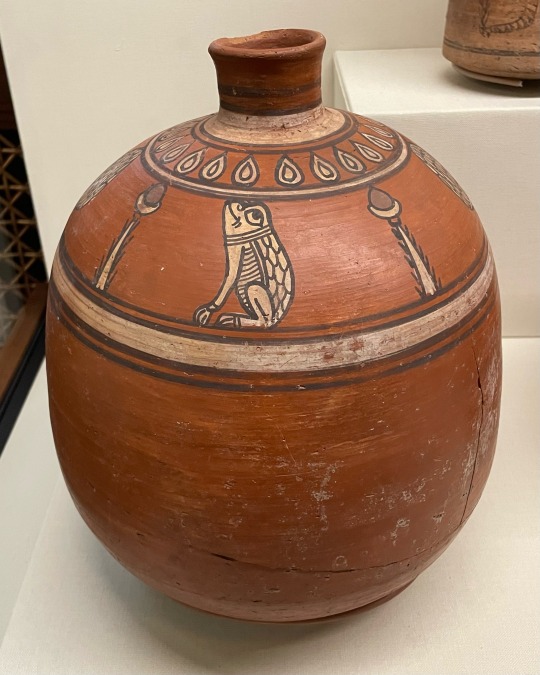
For #FroggyFriday:
polychrome clay jar with seated frogs
Egypt, Ballana, Cemetery B, Tomb 208
Meroitic period, Phase IVA (250-270 CE); excavated in 1963-64
Spotted on display at Oriental Institute - University of Chicago.
#frog#frogs#ceramics#polychrome#ancient Egypt#Meroitic#ancient art#clay#jar#Oriental Institute#animals in art
62 notes
·
View notes
Text

Urpu (jar)
Inca
1400–1535 CE
One of the most distinctive Inca ceramic forms developed in the Cuzco area is the so-called Cuzco bottle, also known as an aryballo because of its similarity to the Greek form. Ranging in size from four to forty-five inches, aryballos (or urpus in Quechua) have big globular chambers, pointed bases, and tall necks with a flared rim. Large urpus were used for the production, storage, and transportation of chicha, a fermented corn beer, as well as other foods. The pointed base of urpus allowed large ones to be set into the earth for stability. On the shoulder of the chamber is usually a central lug, often in the shape of a stylized animal head, as seen here. Ropes were pulled through the handles and secured around the lug for carrying on the backs of porters. Most Cuzco bottles are embellished with polychrome geometric slip designs in black and red on a cream-colored background; representational motifs are rare. On this example, the front half of the chamber is divided into several vertical bands featuring double crosses and zigzag designs on the center panel framed by wider bands of so-called khipu designs. Smaller Cuzco bottles like the present one were probably used to serve liquids, but they may also have fulfilled a votive purpose since a number of them, including miniature ones, were found in burials in distant parts of the Inca empire, from northern coastal Ecuador to the high mountain peaks of central Chile.
source
0 notes
Text
Round 1, Match 3: Decorated Yellow-ish Wares
AND WE'RE BACK!
Jeddito Yellow Ware


Left, a Sikyatki Polychrome jar, 1400-1625, from the Hopi Mesas; Right, a stipple-decorated Jeddito Black-on-Yellow bowl, 1375-1630, Hopi Mesas.
vs.
Hohokam Red-on-Buff


Left, Sacaton Red-on-buff jar, 950-1150, Gila Bend, Maricopa County, central Arizona; Right, Santa Cruz red-on-buff jars, 850-1000, Maricopa County, central Arizona.
More information and examples under the cut:
Jeddito Yellow Ware


Jeddito Black-on-yellow Bowl, 1365–1400 C.E., Homol'ovi, Hopi Mesas.
Jeddito Yellow is an Ancestral Hopi pottery, made on and around the Hopi Mesas in north-central Arizona. There are three mesas, called the Hopi Mesas, where most Hopi villages are congregated; they have been continuously occupied for more than a thousand years. However, the Hopi clans there also have a long and intertwining history of of migration, of congregation of clans, of ethnogenesis and becoming. During the great drought of 1275-1292, some of the people who evacuated southern Utah and northeastern Arizona moved to the Hopi Mesas and joined the ancestral Hopi there. Salado polychrome never took a significant hold here; instead, Jeddito Yellow Wares proliferated.
Jeddito Yellow is a ware with many decorative types within it, from black- and brown-on-yellow, to stipple decorated, to the striking and famed Sikyatki Polychrome. It is built of thin coils, high-fired via coal-burning (unique for the Southwest), porcelain-like in their hardness and brittleness, and uses a very fine, almost microscopic temper. It's been speculated, admittedly a bit fancifully (Hargrave, 1935) that this rich and highly polished yellow pottery may have been the golden plates and cups that the Spanish conquistadores heard about when they were searching for the mythical Cibola. They're beautiful enough to be.
Hohokam Red-on-Buff


Santa Cruz Red-on-buff jar, 750-1150, Pinal County, Arizona (near Phoenix)
Some of the earliest painted pottery in the Southwest, Hohokam red-on-buff exists in multiple striking types - Snaketown, Santa Cruz, and Sacaton Red-on-buff being some of the most widespread and distinctive. They are typically unslipped, with bold or hatched repeating designs in red paint. They were made in central and southern Arizona.
Unlike Ancestral Pueblo and Mogollon pottery, which was made with the coil-and-scrape technique, Hohokam pottery was made with a technique called "paddle-and-anvil." It was still coil-built, but the coils used to build the pot were typically bigger than the thin coils of northern and eastern types. To merge the coils and thin the pot, potters used a wooden paddle to strike the outside, and a stone anvil held against the inside to brace against. In this way the coiled walls were thinned, shaped, compressed, and drawn up.
21 notes
·
View notes
Video
Trinidad Medina, Zia Pueblo, Polychrome Jar, ca. 1920, Native clay, 9/8/21 #crystalbridges by Sharon Mollerus
#artmuseum#ca. 1920#Native clay#ceramics#Bentonville#crystalbridges#Arkansas#Native American#Zia Pueblo#Polychrome Jar#Trinidad Medina#Crystal Bridges Museum of American Art#AR
4 notes
·
View notes
Photo

OPIUM polychrome, ceramic
#from me#opium#opium jar#ceramics#polychrome#home decor#jar#smithsonian#golden#comspo#photography#photograph#museum#archives#archival#?
112 notes
·
View notes
Photo
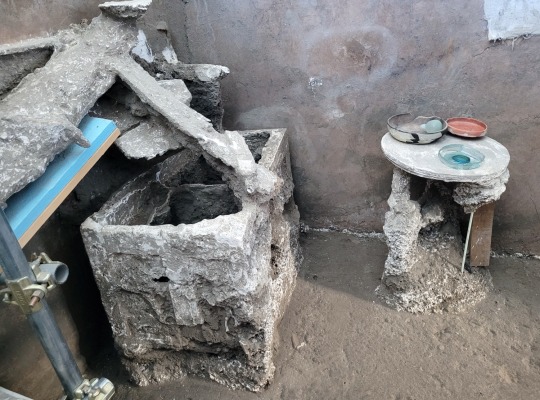
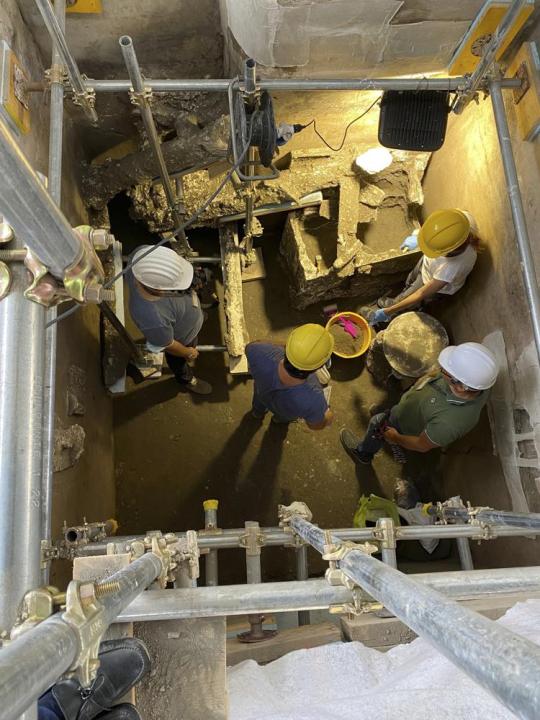

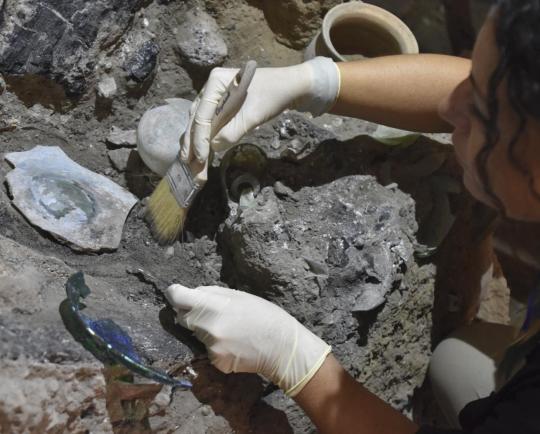
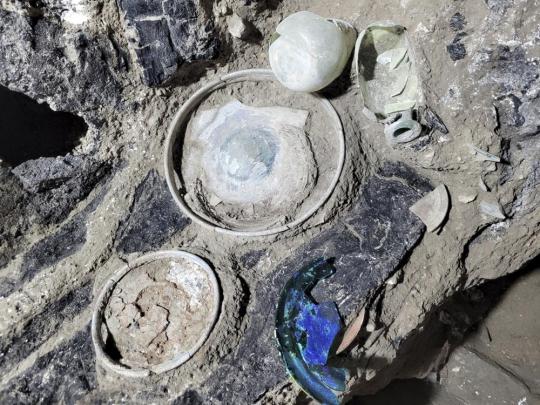
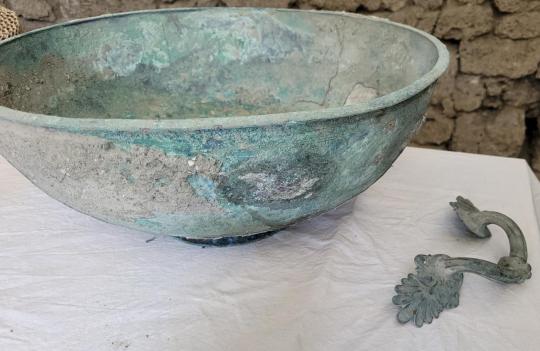

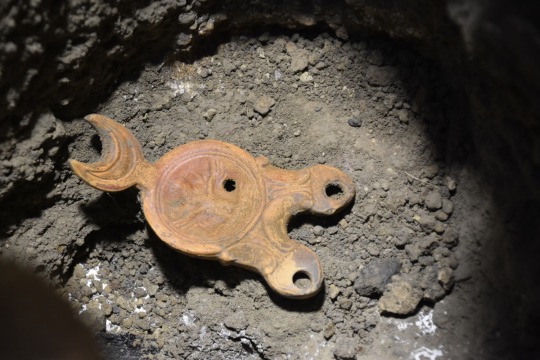

Discoveries in Pompeii Reveal Lives of Lower and Middle Classes
The latest discoveries in the excavation of Pompeii’s Regio V neighborhood are fully furnished utility spaces, of great archaeological significance for the details they preserve of a common domestic context in the 1st century Roman town.
The room was found in the House of the Enchanted Garden, a beautifully frescoed home with a lararium (a shrine to the household gods) that is one of the largest ever discovered in Pompeii. In 2021, archaeologists undertook an excavation and restoration of rooms on the ground floor in front of the lararium and the stories above it. They uncovered four rooms, two on the ground floor and two above, that were furnished. One was unfinished, with unplastered walls and an earthen floor, a jarring contrast in a house so decorated with such fine frescoes. The unfinished room was used for storage.
Archaeologists were able to make casts of the furnishings in the room which left a cavity in the hardened ash that could be filled with plaster. One room contained a bed frame and a pillow. The texture of the fabric was imprinted in the ash and is visible on the plaster cast. It is a very simple cot with ropes strung across the sides. There isn’t even a mattress, let along any decoration. Next to the bed was a wooden trunk divided into two compartments. The lid was open, but broken when the beams and floorboards of the story above collapsed in the eruption. Inside the trunk, archaeologists found a terra sigillata saucer and a double-spouted oil lamp depicting Zeus in the act of transforming into an eagle. Next to the trunk was a circular three-legged table with a shallow ceramic bowl containing two small glass bottles, a blue glass saucer and a terra sigillata bowl.
In the storage room, archaeologists were able to make two casts: a shelf and a group of wooden planks in different sizes, cuts and finishes, tied together. This was probably a collection of raw materials for assorted home maintenance projects from furniture patching to roof repair. Outside the room in a small hallway another utilitarian treasure was found: a tall wooden cabinet with at least four doors and five internal shelves. The top of the wardrobe and the front doors were damaged when the floor above the room collapsed. The remains of jugs, amphorae, bowls and plates were found on the damaged top shelf.
The excavation of the upper rooms revealed materials that were in the process of collapsing onto the rooms below. Of enormous archaeological value is a unique group of wax writing tablets. The group consists of seven triptychs tied both vertically and horizontally by a cord. A large cupboard, collapsed in the eruption, was also excavated. It contained different types of common use ceramics for kitchen and dining, as well as fine terra sigillata ceramics and glass. There was also a set of small bronze vessels, including a basin with palm leaf-shaped handles and a small jug decorated with a sphinx and lion’s head. Another special treasure is an incense burner shaped like a cradle with a male figure at one end. The polychrome paint coloring the figure and decorating the cradle with geometric designs is perfectly preserved.
The excavation overlapped onto a residential property behind the House of the Enchanted Garden, and there the plaster cast technique revealed the imprint of cane lathing in the mortar of a collapsed false ceiling. The cast shows the guts of Pompeiian construction: bundles of caning tied together by a thin cord and covered by a gauze-like fabric to separate the lathing from the wet mortar. Casts were also obtained of what appears to be wood paneling on the north, east and south walls of the room. Some are carved with coffered decoration; others are inlaid with delicate bone elements.
#Discoveries in Pompeii Reveal Lives of Lower and Middle Classes#House of the Enchanted Garden#archeology#archeolgst#ancient artifacts#history#history news#ancient history#ancient culture#ancient civilizations#roman empire#roman history
75 notes
·
View notes